While job boards remain important for recruiting restaurant and hospitality workers, social media can further improve your hiring process. This article provides an overview of how to use social media in recruitment.
Benefits of Recruiting Through Social Media
From reaching passive job seekers to increasing the visibility of job ads, we’ll walk you through the top benefits of using social media for recruiting restaurant and hospitality talent to help you find qualified candidates more effectively.
Reach passive job seekers
Passive job seekers are individuals who aren’t actively looking for a new job but would consider one if a better opportunity arises. These individuals aren’t browsing platforms like Indeed or even ZipRecruiter, nor are they checking out company career pages to find openings.
Social media reaches passive job seekers by sharing information on platforms they already use. According to a study, 88% of 18 to 29-year-olds and nearly 80% of 30 to 49-year-olds use social media to communicate with friends and family, stay informed about current events and find entertainment.
Boosts employer brand and reputation
When hotels and restaurants post content about their employees and core values, they attract candidates who align with their culture. In addition to showcasing your company’s culture, maintaining an active social media account can enhance your credibility. This is especially important, as data shows that 82% of job seekers consider a company’s brand and reputation before applying.
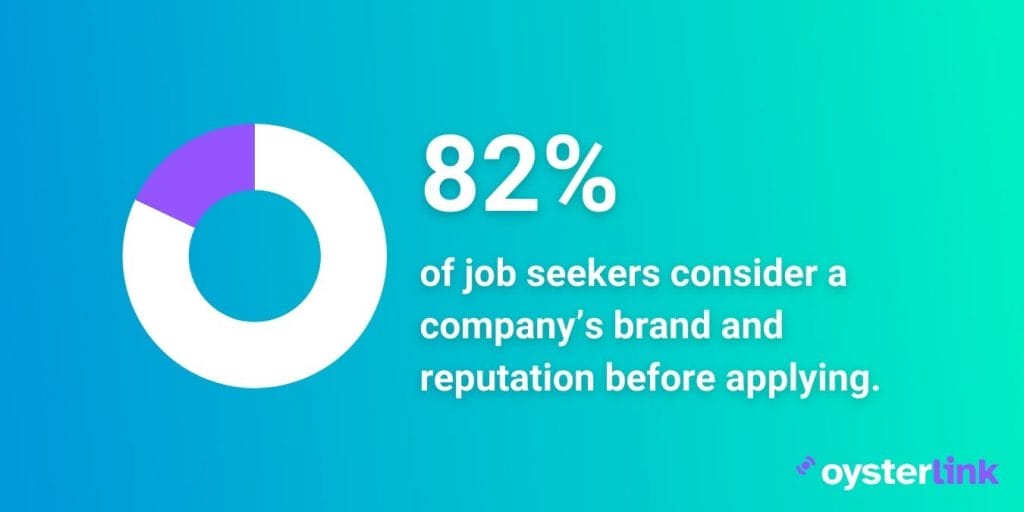
Increases job posting’s visibility
Social media’s sharing functions enable employees to easily share job ads, increasing visibility through their personal networks. Data shows that content shared by employees gets eight times more engagement than those shared from company social media accounts. Encouraging employees to interact with your content helps you connect with a broader pool of candidates through trusted referrals.
How To Use Social Media for Recruitment
Using social media for recruitment is only effective if you have a following. Whether you’re creating a new account or optimizing your current profiles, here are tips to help you maximize your recruitment efforts.
Create social media profiles
The top social media for recruitment include Facebook, Instagram, TikTok, LinkedIn and Twitter. If your company isn’t on any of these platforms, focus on one or two where your target audience is most active. Below are some tips for creating profiles on each of the mentioned platforms.
| Platform | Profile creation tips |
|---|---|
| TikTok | Use underscores in your handle for readability if your business name is long |
| Link to your careers page in your bio for easy access to job openings | |
| X | Ensure your header (1500×500 pixels) and profile photo (400×400 pixels) meet the recommended dimensions |
| Clearly state what you do in your bio (max 160 characters) and add your website for more info | |
| Use your business logo for your profile picture | |
| Complete the “About” section with your company’s mission, values and a link to job openings | |
| Fill out the About section with your company’s values, mission and unique selling proposition | |
| Use the “Life” section to highlight employee testimonials and workplace culture | |
| Use your logo as the profile picture for brand consistency | |
| Write a short bio that reflects your company’s values and include a link to your careers page |
Develop brand awareness
This step may require the assistance of your marketing team, as it involves strategic planning, knowledge of audience engagement and content creation. If you’re curious about what developing brand awareness entails, here’s a brief overview of the key elements involved.
Understand your candidates and create a persona
For each position you’re hiring for, identify the skills, traits, what matters to candidates and the challenges they face. Knowing this will help you develop effective ways to appeal to them. Ideally, this process would include research methods such as analyzing demographics and behaviors through tools like Google Analytics, Facebook Insights and surveys.
However, if you don’t have access to this data yet, creating a candidate persona without specific insights can still serve as a useful starting point for understanding potential candidates. A candidate persona is a fictional representation of what an ideal candidate for a particular role looks like. A candidate persona may look something like this:
Candidate persona: Sarah the Service-Oriented Professional
Position: Hotel Concierge
Demographics:
- Age: 25-35
- Education: Bachelor’s degree in Hospitality Management or related field
- Experience: 2-3 years in customer service or hospitality roles
Key skills:
- Excellent communication skills (verbal and written)
- Proficiency in hotel management software (e.g., Opera, Maestro)
- Multitasking skills to handle busy check-in/check-out periods
Personal qualities:
- Friendly and approachable demeanor
- Ability to remain calm under pressure
- Adaptable to changing situations and guest needs
What she cares about:
- Providing exceptional guest experiences and creating memorable stays
- Building positive relationships with guests and colleagues
- Opportunities for professional development and advancement within the hospitality industry
- Work-life balance and a supportive work environment
Top challenges:
- Managing high-stress situations during peak times without compromising service quality
- Balancing multiple guest requests and priorities simultaneously
- Staying updated on local attractions and events to provide informed recommendations
- Navigating difficult guest interactions while maintaining professionalism and empathy
Based on this persona example, you can create content that features current Concierges at your company, share their experiences, what they love about their jobs and how they deliver exceptional guest service. This approach will resonate with real life candidates like our fictional Sarah who are passionate about hospitality and eager to make a positive impact.
Become a valuable industry resource
The key to building brand awareness is to create useful content or serve as a source of credible information. This positions your business as a thought leader, making people more likely to want to work with you. You can’t just create a social media account, identify your target audience and then immediately proceed to job posting — this approach only works on job boards. On social media, you need to provide value to engage with your audience effectively.
Here’s a good example from Marriott International, where their Executive Assistant Manager at the St. Regis in Mexico City shares how he creates an unforgettable stay for guests.
Content like this — sharing tips, best practices, and personal experiences — is valuable because it builds trust, showcases expertise and connects with potential candidates on a personal level.
Post job ads
Once you’ve established your brand on social media, shared useful information and communicated your company culture, you can start posting job ads. You can choose to post organically (unpaid) or allocate a budget for targeted paid ads. Targeted ads allow you to reach candidates based on job titles, locations and other criteria. You can also combine both strategies, depending on your budget, resources and priorities.
Below are some tips for posting job ads on different platforms:
| Platform | Profile creation tips |
|---|---|
| TikTok | Create short videos showcasing the work environment and team culture |
| Use trending sounds or challenges to make your job ads more relatable | |
| X | Keep job tweets concise |
| Engage with followers and retweet relevant posts to increase reach | |
| Use engaging visuals to grab attention | |
| Use Facebook’s job posting feature for easy application | |
| Write detailed job descriptions highlighting company culture and career growth opportunities | |
| Use LinkedIn’s targeting features to reach specific professional groups | |
| Post behind-the-scenes content to give a glimpse of workplace culture | |
| Use Stories for reminders about job openings |
For each job posting, use relevant hashtags to reach your target audience faster. You can find keywords related to your job by using the social media platform’s search bar or HootSuite’s free hashtag generator. Alternatively, you can pay for tools like SproutSocial to enhance your hashtag strategy.
Leveraging video content for recruitment
Video content has become increasingly popular on social media and can serve as a powerful recruitment tool. Consider incorporating the following types of videos to attract potential candidates:
- Virtual tours: Provide a behind-the-scenes look at your workplace to give candidates a sense of the environment and culture.
- Employee testimonials: Share interviews with current employees discussing their experiences and growth within the company.
- Day-in-the-life segments: Feature daily routines of various roles to offer insights into job responsibilities and team dynamics.
Utilizing video content can enhance engagement and provide a more immersive experience for potential applicants.
Utilizing employee advocacy
Your current employees are one of your most valuable assets in recruitment. When they share job openings and company content on their personal social media profiles, it not only amplifies your reach but also adds credibility and trust to your hiring efforts.
- Incentivize sharing: Recognize and reward employees who actively support recruitment initiatives. Offering incentives shows that you value their contributions and motivates participation.
- Provide shareable content: Empower your team with well-crafted, engaging posts they can easily share. Streamlining this process ensures your message reaches a wider audience effectively.
- Highlight employee stories: Feature success stories and personal achievements of your staff. This approach humanizes your brand and attracts candidates who align with your company values.
Leveraging employee advocacy is a game-changer for recruitment. By tapping into the networks of your existing team members, you can build a more robust, credible, and far-reaching hiring strategy.
Measure and improve
Ideally, you should set specific targets before creating any content. However, if you’re still exploring what works for your audience, it’s alright to create content first and measure performance later. Just make sure to consistently track your results so you can adjust your strategy.
Pay attention to metrics such as:
- Engagement rates: Assess likes, comments, and shares to determine the effectiveness of your content.
- Application sources: Identify which social media platforms are driving the most applications.
- Conversion rates: Measure the percentage of engaged users who proceed to apply.
What To Avoid When Using Social Media for Recruiting
Here are common mistakes to avoid when recruiting restaurant and hospitality talent through social media.
- Only posting job ads without sharing relevant, useful content
- Failing to monitor results and adjust your strategy as needed
- Cross-posting the same content from Facebook to other platforms without customization
- Neglecting to engage with your community
- Being unclear about your application process
- Allowing social media to create bias when conducting background checks
Examples of Brands Using Social Media for Recruiting the Right Way
We’ve compiled some of the best brands that are using social media effectively for recruitment.
Hilton
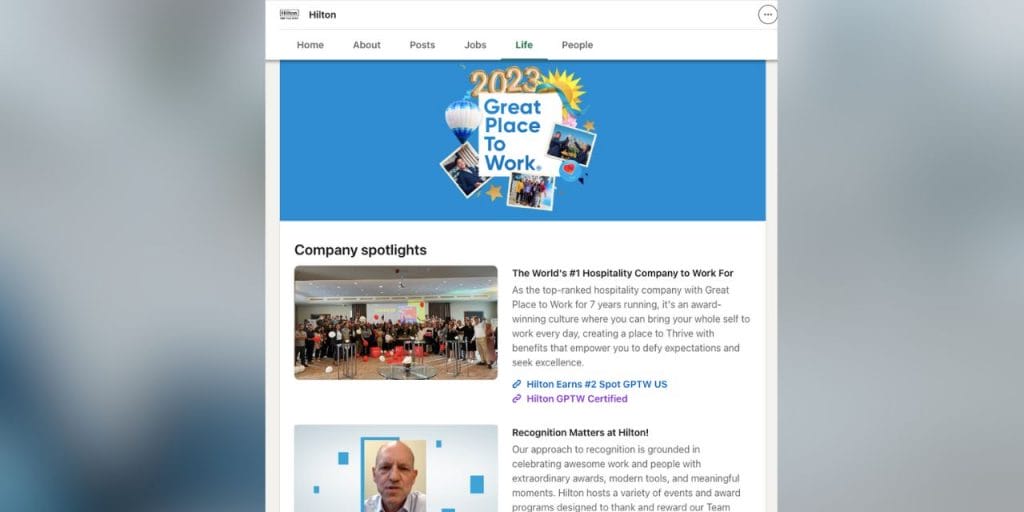
Hilton’s LinkedIn profile, particularly under the “Life” section, effectively showcases why it’s a top employer. They share engaging videos and photos that emphasize their commitment to rewarding employees for their hard work and achievements. By proudly displaying awards, such as being named a “Great Place to Work,” Hilton reinforces its reputation as an employer of choice.
Hyatt
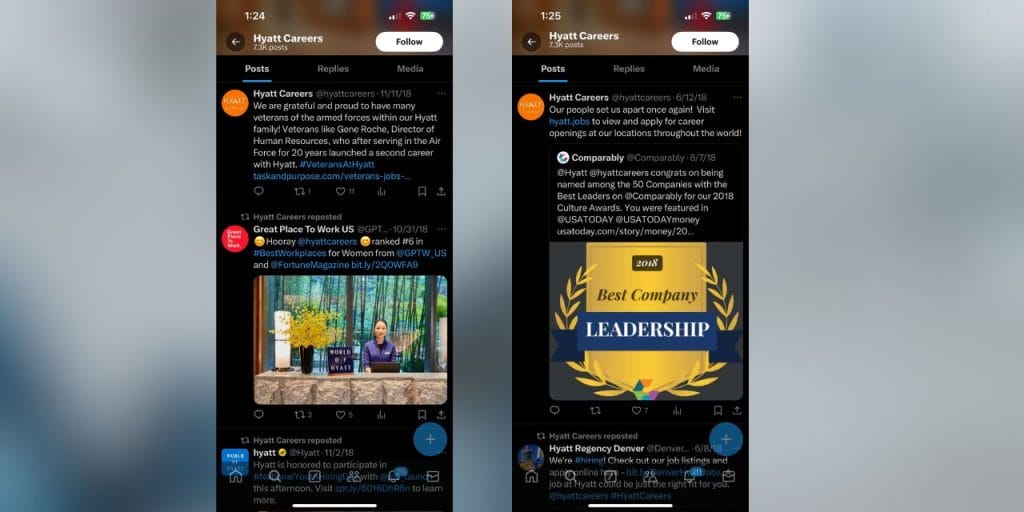
Hyatt maintains a dedicated X account focused on showcasing its vibrant company culture and the diverse experiences of its employees. The account regularly amplifies news and updates from various Hyatt properties, creating a lively feed that keeps followers engaged.
IHG
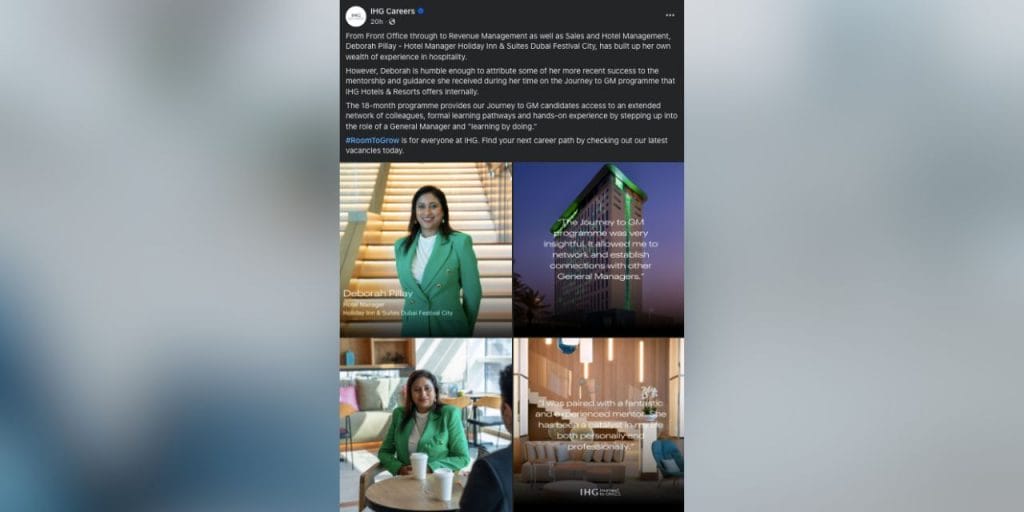
Just like Hyatt, IHG has a dedicated social media account for career-related posts. They share stories that highlight how team members receive mentorship and training. By showcasing these updates, IHG positions itself as a supportive employer that invests in the growth and development of its workforce.
Starbucks

On Instagram, Starbucks takes advantage of the platform’s visual appeal to promote job postings through a mix of striking employee profile photos and engaging graphics. They highlight various employee benefits, such as educational sponsorship programs and vibrant workplace culture. The posts showcase not just job openings but also the values that make Starbucks a desirable employer, drawing in candidates who resonate with their mission.
Shake Shack
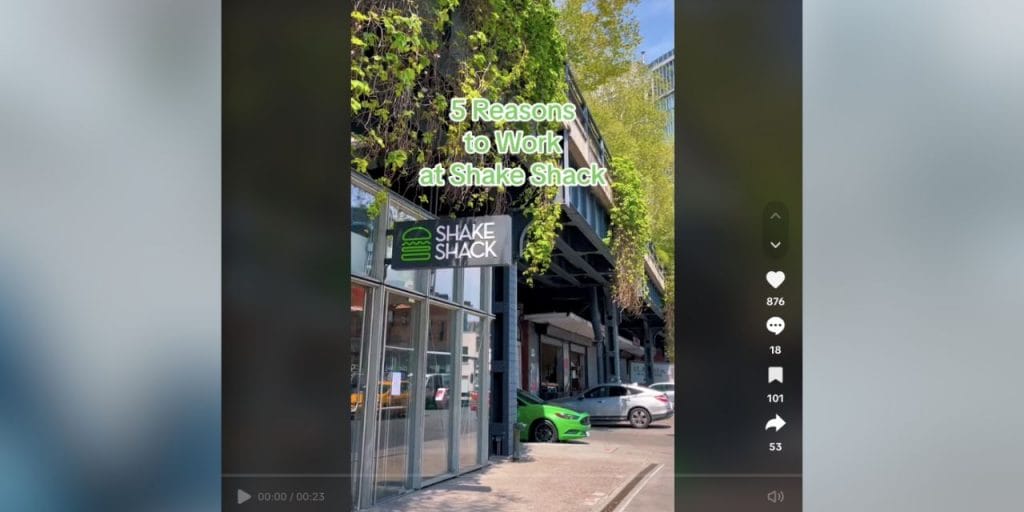
Shake Shack uses TikTok to create fast-paced videos that summarize the essence of working at their restaurants. They produce short clips that share employee benefits and fun workplace activities. Highlighting perks like flexible scheduling makes Shake Shack appealing to particularly younger audiences looking for a work environment that values work-life balance.
FAQ on How Restaurants Use Social Media to Recruit
Social media platforms allow restaurants to share job postings and highlight their work culture, attracting individuals who aren’t actively job hunting but may be interested in a better opportunity.
Platforms like Instagram, Facebook, TikTok, and LinkedIn are ideal, as they allow businesses to showcase their culture, post job openings, and reach both active and passive job seekers.
Restaurants should post behind-the-scenes videos, employee testimonials, day-in-the-life content, and engaging visuals that showcase their culture, values, and benefits.
When employees share job openings or company content on their social networks, it adds credibility and reaches a broader audience, often leading to higher engagement and better-quality applicants.
Avoid only posting job ads without valuable content, neglecting to track performance metrics, and failing to customize content for each platform. Engaging with the audience and showcasing your culture is key.

Written by Rea Gierran
With a background in Communication Arts, Rea’s expertise lies in content marketing and copywriting. Her published works can be seen on online news websites such as Rappler and Adobo magazine. Outside of her work, Rea takes on the role of a “momager” for Shiro, a TikTok dogfluencer.

Reviewed by Stefan Petrov
With over 10 years of experience as a writer and editor, Stefan has worked in the automotive, IT, health and hospitality industries. Familiar with Google Search Console and other SEO tools like Ahrefs and Semrush, Stefan uses his experience to create content that’s visually appealing to the user but also ranks in the SERPs.




